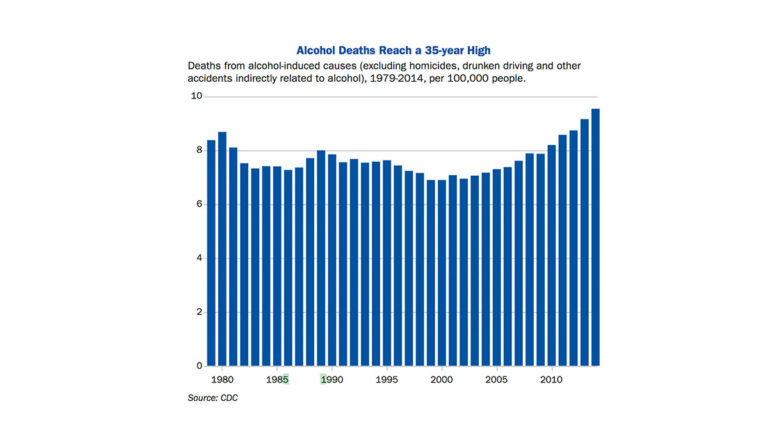Attention: Alcohol Deaths Still Rising
Alcohol death rates are at a 35-year high. Alcohol’s wide acceptance and stark increase in death rates requires national attention.

Read Time: 2 minutes
Published:
In November 2017, the Trust for America’s Health and Well Being Trust released a report called Pain in the Nation: The Drug, Alcohol and Suicide Crises and the Need for a National Resilience Strategy. The report covers three crises, but alcohol’s wide acceptance and stark increase in death rates in the past couple of decades requires attention.
The report points out that liver diseases, alcohol poisoning, and other diseases account for 33,200 alcohol-related deaths in the last year. If car crashes—30% of which are alcohol-related—and other injuries are factored into the overall death rate due to alcohol, the drug becomes the fourth leading preventable cause of death in the United States at 88,000 deaths annually.
As the graph above shows, alcohol deaths are at a 35-year high. They increased by 47% between 2000 and 2015. Women have experienced the most dramatic proportional increases in death rates (75%). White alcohol-related deaths have increased by 130% since 1999, compared to a 27% increase in the rate of Hispanic deaths and a 12% decrease in the rate of African American deaths.
Further, alcohol consumption is a known risk factor for suicide, homicide, injury, and other drug use, which further exacerbates its overall burden. Twenty-three percent of suicide deaths and 40% of attempts, for example, are linked with alcohol use.
The report calls for a “National Resilience Plan,” or comprehensive action against the many factors that contribute to excessive alcohol use at the policy level. The most effective alcohol-related policies they cite focus on several strategies, which include:
- Make it more expensive to increase excise (based on volume sold) and sales taxes (percent of retail price);
- Make it less accessible to limit the number of retailers in any given area and the days and hours when it can be sold;
- Outlaw sales to kids or people who are already drunk which holds the owner or server liable for injuries or deaths related to illegal sale of alcohol;
- Raise the legal drinking age which protects drinkers from suicide, homicide, and future alcohol and other drug dependence;
- Focus on early childhood and families which will likely have the most impact by preventing entire lifetimes of mental health challenges and physical illnesses related to substance misuse; and
- Address and alter social norms that normalize excessive alcohol use.
Databyte via Pain in the Nation: The Drug, Alcohol, and Suicide Crises and the Need for a National Resilianece Strategy. Trust for America’s Health.



